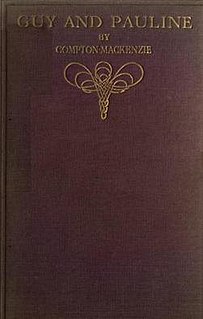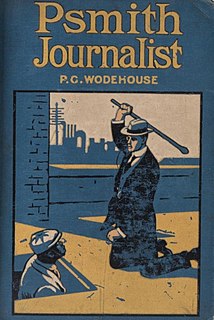 W
WBealby: A Holiday is a 1915 comic novel by H. G. Wells.
 W
WBoon is a 1915 work of literary satire by H. G. Wells. It purports, however, to be by the fictional character Reginald Bliss, and for some time after publication Wells denied authorship. Boon is best known for its part in Wells's debate on the nature of literature with Henry James, who is caricatured in the book. But in Boon Wells also mocks himself, calling into question and ridiculing a notion he held dear—that of humanity's collective consciousness.
 W
WWritten by Baroness Orczy and first published in 1915, The Bronze Eagle: A Story of the Hundred Days, is a romance set in France following the period of the Revolution and the expulsion of the Bourbons. Its central plot lies in the intrigues of their followers and those of Napoleon Bonaparte.
 W
WDoctor Syn: A Tale of the Romney Marsh is the first in the series of Doctor Syn novels by Russell Thorndike. In this story we are introduced to the complex Christopher Syn, the kindly vicar of the little town of Dymchurch. Syn seems pleasant but we soon learn that he has a sinister past. At one time he was the vicious pirate Captain Clegg and he is also the mysterious "Scarecrow of Romney Marsh", masked leader of the local smugglers.
 W
WThe Good Soldier: A Tale of Passion is a 1915 novel by the British writer Ford Madox Ford. It is set just before World War I, and chronicles the tragedy of Edward Ashburnham, the soldier to whom the title refers, and his seemingly perfect marriage, along with that of his two American friends. The novel is told using a series of flashbacks in non-chronological order, a literary technique that formed part of Ford's pioneering view of literary impressionism. Ford employs the device of the unreliable narrator to great effect, as the main character gradually reveals a version of events that is quite different from what the introduction leads the reader to believe. The novel was loosely based on two incidents of adultery and on Ford's messy personal life.
 W
WGuy and Pauline is a 1915 novel by the British writer Compton Mackenzie. It was begun on Capri and written in three and a half months, and remained Mackenzie's favourite of his own works. It was published in America with the alternative title of Plashers Mead.
 W
WThe Holy Flower is a 1915 novel by H. Rider Haggard featuring Allan Quatermain. It was serialised in The Windsor Magazine from issue 228 to 239, illustrated by Maurice Greiffenhagen, and in New Story Magazine from December 1913 through June 1914. The plot involves Quatermain going on a trek into Africa to find a mysterious flower.
 W
WThe Lost Prince is a novel by British-American author Frances Hodgson Burnett, first published in 1915.
 W
WThe Man Who Bought London is a 1915 crime novel by the British writer Edgar Wallace. It was originally published as a magazine serialisation.
 W
WThe Melody of Death is a 1915 crime novel by the British writer Edgar Wallace. Believing that he is suffering from a fatal illness a newly-married man begins to commit a series of crimes to make sure his wife will be provided for after his death.
 W
WOf Human Bondage is a 1915 novel by W. Somerset Maugham. It is generally agreed to be his masterpiece and to be strongly autobiographical in nature, although Maugham stated, "This is a novel, not an autobiography; though much in it is autobiographical, more is pure invention." Maugham, who had originally planned to call his novel Beauty from Ashes, finally settled on a title taken from a section of Spinoza's Ethics. The Modern Library ranked Of Human Bondage No. 66 on its list of the 100 best English-language novels of the 20th century.
 W
WPointed Roofs, published in 1915, is the first work in Dorothy Richardson's (1873–1957) series of 13 semi-autobiographical novels titled Pilgrimage, and the first complete stream of consciousness novel published in English. The novelist May Sinclair (1863–1946) first applied the term "stream of consciousness" In a review of Pointed Roofs.
 W
WPsmith, Journalist is a novel by P.G. Wodehouse, first released in the United Kingdom as a serial in The Captain magazine between October 1909 and February 1910, and published in book form in the UK on 29 September 1915, by Adam & Charles Black, London, and, from imported sheets, by Macmillan, New York, later that year.
 W
WThe Rainbow is a novel by British author D. H. Lawrence, first published by Methuen & Co. in 1915. It follows three generations of the Brangwen family living in Nottinghamshire, particularly focusing on the individual's struggle to growth and fulfilment within the confining strictures of English social life. Lawrence's 1920 novel Women in Love is a sequel to The Rainbow.
 W
WThe Research Magnificent is a 1915 novel by H. G. Wells.
 W
WSalute to Adventurers is a 1915 novel by John Buchan.
 W
WThe Sea Hawk is a novel by Rafael Sabatini, originally published in 1915. The story is set over the years 1588–1593 and concerns a retired Cornish seafaring gentleman, Sir Oliver Tressilian, who is villainously betrayed by a jealous half-brother. After being forced to serve as a slave on a galley, Sir Oliver is liberated by Barbary pirates. He joins the pirates, gaining the name "Sakr-el-Bahr", and swears vengeance against his brother.
 W
WSomething Fresh is a novel by P. G. Wodehouse, first published as "Something New" in the United States, by D. Appleton & Company on 3 September 1915. It was published in the United Kingdom as "Something Fresh" by Methuen & Co. on 16 September 1915. There are a number of differences between the American and British versions, but essentially, it is the same book. The novel introduces Lord Emsworth of Blandings Castle, whose home and family reappear in many of Wodehouse's later short stories and novels.
 W
WThe Thirty-Nine Steps is an adventure novel by the Scottish author John Buchan. It first appeared as a serial in Blackwood's Magazine in August and September 1915 before being published in book form in October that year by William Blackwood and Sons, Edinburgh. It is the first of the five novels featuring Richard Hannay, an all-action hero with a stiff upper lip and a miraculous knack for getting himself out of sticky situations.
 W
WThe Valley of Fear is the fourth and final Sherlock Holmes novel by Sir Arthur Conan Doyle. It is loosely based on the Molly Maguires and Pinkerton agent James McParland. The story was first published in the Strand Magazine between September 1914 and May 1915. The first book edition was copyrighted in 1914, and it was first published by George H. Doran Company in New York on 27 February 1915, and illustrated by Arthur I. Keller.
 W
WVictory is a psychological novel by Joseph Conrad first published in 1915, through which Conrad achieved "popular success." The New York Times, however, called it "an uneven book" and "more open to criticism than most of Mr. Conrad's best work."
 W
WThe Voyage Out is the first novel by Virginia Woolf, published in 1915 by Duckworth; and published in the US in 1920 by Doran.